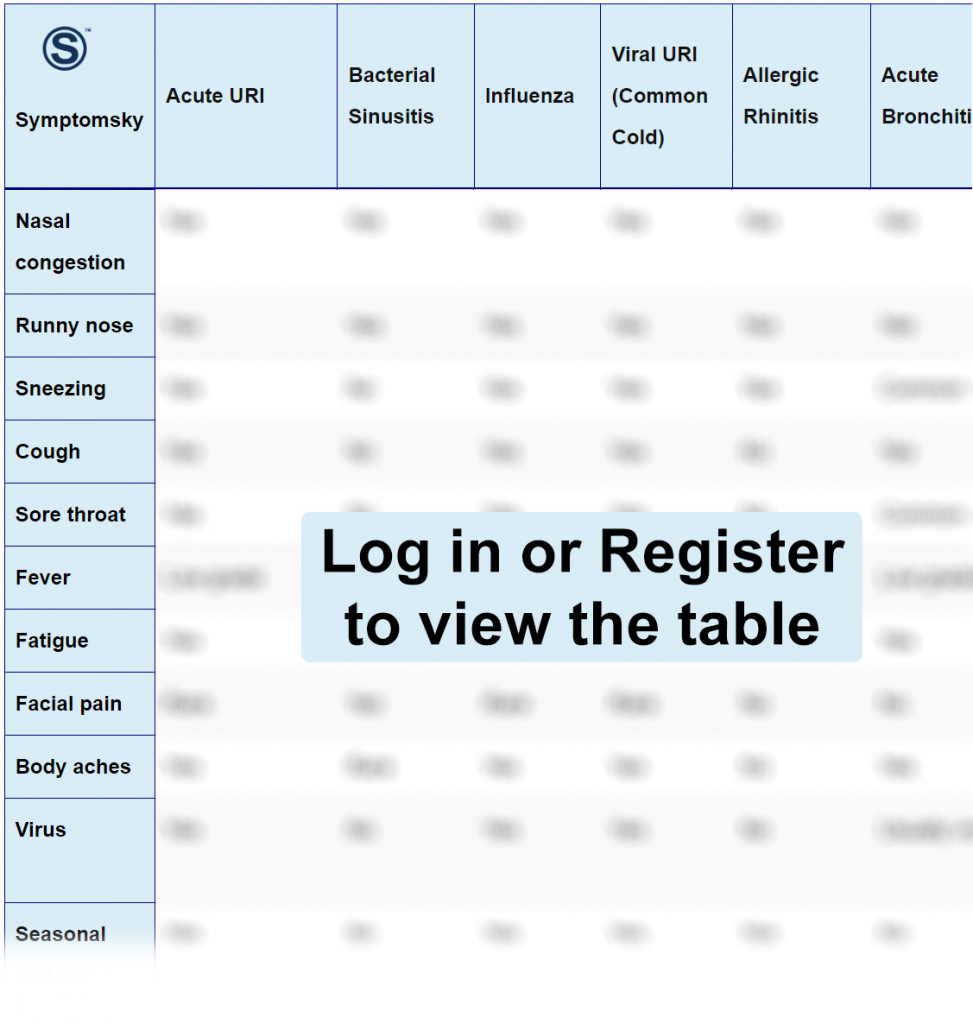Contents
- 1 Acute Upper Respiratory Infection Differential Diagnosis Table:
- 2 How to Distinguish Upper Respiratory Infections from Other Diseases
- 2.1 Distinguish Bacterial Sinusitis from Acute Upper Respiratory Infections – Diagnosis
- 2.2 Distinguish Influenza from Acute Upper Respiratory Infections – Diagnosis
- 2.3 Distinguish Common Cold from Acute Upper Respiratory Infections – Diagnosis
- 2.4 Distinguish Allergic Rhinitis from Acute Upper Respiratory Infections – Diagnosis
- 2.5 Distinguish Acute Bronchitis from Acute Upper Respiratory Infections – Diagnosis
- 2.6 Distinguish Acute Pharyngitis from Acute Upper Respiratory Infections – Diagnosis
- 2.7 Distinguish Pneumonia from Acute Upper Respiratory Infections – Diagnosis
- 2.8 Distinguish Pertussis from Acute Upper Respiratory Infections – Diagnosis
- 3 Common Red Flags with Upper Respiratory Infections
Acute Upper Respiratory Infection Differential Diagnosis Table:

The human body is a storehouse for various microorganisms, but in moderate quantities, these microorganisms help the proper functioning of our organism. Despite this, there are times when an infection can develop. Infection occurs when this moderate amount of microorganism doubles exponentially. The problems occur when microorganisms that belong to our system migrate to inappropriate places, or worse when unknown microorganisms enter our body, producing various alterations compromising our organs.
Acute respiratory infections are nothing more than diseases that invade the respiratory system and are transmitted from person to person through the respiratory system or transmitted through respiratory droplets either by coughing or sneezing from an infected person to a healthy one.
These infections can be classified depending on the structure of the respiratory system that invades: high and low tract respiratory infections. An example of the high ones are acute rhinitis, sinusitis. An example of the low ones are laryngitis, otitis.
In this type of infections, there is what is called an incubation period, which means that after a person catches the infection, the symptoms do not appear instantly. The symptoms appear 48-72 hours after the infection. Most common symptoms are cough, rhinorrhea, nasal obstruction, odynophagia, etc.
How to Distinguish Upper Respiratory Infections from Other Diseases
Distinguish Bacterial Sinusitis from Acute Upper Respiratory Infections – Diagnosis
It is called sinusitis, the inflammation of the internal walls of the nose and the nasal cavities, which causes an amount of fluid more than usual.
- Sinusitis is a symptom of almost all acute upper respiratory infections; however, in Bacterial sinusitis, it is more predominant, and because it has the longest duration of time, this accumulation of fluid creates a space where the bacteria are hosted and grow, producing what is called bacterial sinusitis.
- In acute upper respiratory infections, the symptoms last 5-10 days, while in bacterial sinusitis, it lasts more than 10.
- In acute upper respiratory infections, nasal discharges or fluids are clear and fluid, while in bacterial sinusitis, they are yellowish or greenish.
- In acute upper respiratory infections, headaches are not so frequent, while in bacterial sinusitis, they are severe around the eyes or when the patient bends down.
Distinguish Influenza from Acute Upper Respiratory Infections – Diagnosis
Influenza is a seasonal contagious respiratory disease caused by influenza viruses.
- In acute upper respiratory infections, fever and chills are unusual, while in influenza, they are very common.
- In acute upper respiratory infections, head and muscle aches are unusual, while in influenza, they can be very severe.
- Symptoms such as cough, sneezing, and nasal congestion usually happen in influenza (depends on the patient), while in acute upper respiratory infections, they are very common.
Distinguish Common Cold from Acute Upper Respiratory Infections – Diagnosis
They have no difference since colloquially upper respiratory infections are known as the common cold.
Distinguish Allergic Rhinitis from Acute Upper Respiratory Infections – Diagnosis
- Allergic Rhinitis is an immune response detonated by an allergic component, usually a chemical or environmental substance, while acute upper respiratory infections are respiratory viral infections.
- Allergic Rhinitis causes itching around eyes, nose, and sneezing, while in acute upper respiratory infections, these symptoms are not common
Distinguish Acute Bronchitis from Acute Upper Respiratory Infections – Diagnosis
- Acute bronchitis does not belong to high acute respiratory infections, it is classified as low tract respiratory infections due to the affected structure which in this case are the bronchioles.
- There are very marked symptoms in acute bronchitis such as fatigue, frequent cough (with sputum or not), chest pain (especially when coughing), while in acute upper respiratory infections these symptoms are not common.
Distinguish Acute Pharyngitis from Acute Upper Respiratory Infections – Diagnosis
- Pharyngitis presents this marked symptomatology to the physical exam: fever, headache, cervical lymphadenopathy, pharynx erythema, ear pain, and tonsillar exudate while in acute upper respiratory infections these symptoms are not common.
Distinguish Pneumonia from Acute Upper Respiratory Infections – Diagnosis
Pneumonia occurs when an infection travels to the lobes of the lungs; it can be viral or bacterial.
- Pneumonia causes chest pain when breathing or coughing, cough with sputum, fever, cramps, nausea, vomiting while in acute upper respiratory infections these symptoms are not common.
Distinguish Pertussis from Acute Upper Respiratory Infections – Diagnosis
To establish differences between both, it is good to consider the 3 classic stages of pertussis:
- Catarrhal stage (1-2 weeks): At this stage, the symptoms are very similar to a viral acute upper respiratory infection with cough and coryza, unusual fever, body aches, headache; cough gradually increases before the second stage (paroxysmal).
- Paroxysmal stage (2-8 weeks): The cough begins to increase with a great number of series followed by a short gap in breathing; patients present sweating, cyanosis in pediatric patients is frequent. Cough usually precipitates when the patients laugh or exercise.
- Convalescent stage (10 weeks-): Cough decreases, the recovery process is slow, and other URIs may appear at this stage.
In conclusion, it can be said that these two diseases can be confused until the patient enters the paroxysmal stage where cough is very pathognomonic of Pertussis and becomes the main differential diagnosis.
Common Red Flags with Upper Respiratory Infections
It is important to know that acute upper respiratory infections are more frequent in children than adults; actually, they are the main reasons for consultations in pediatrics.
More than 90% of these infections come from viruses, which means the treatment will be mostly symptomatic and supportive; NO ANTIBIOTICS ARE REQUIRED.
Keep in mind that children who present constitutional symptoms (weight loss, anorexia (lack of appetite)) it is very important to look over differential diagnoses and go deeper into the clinical history.
